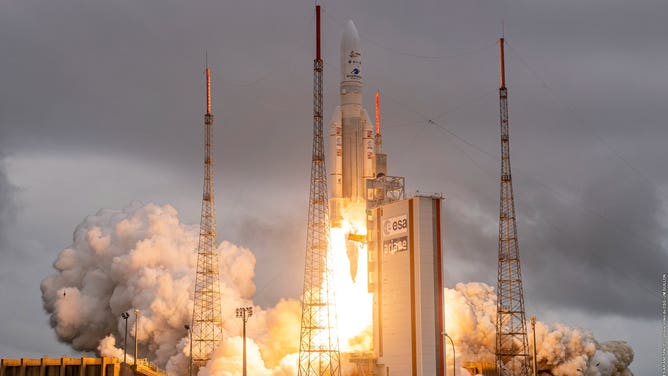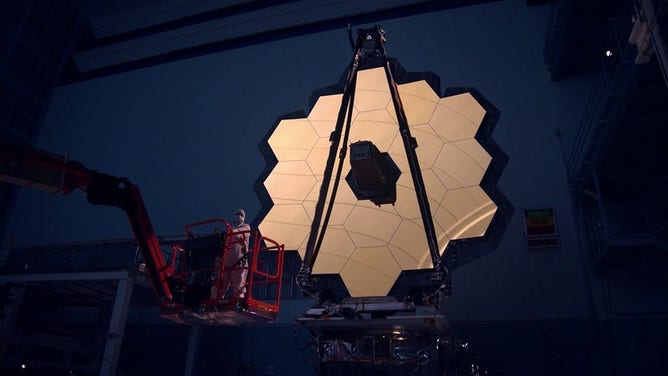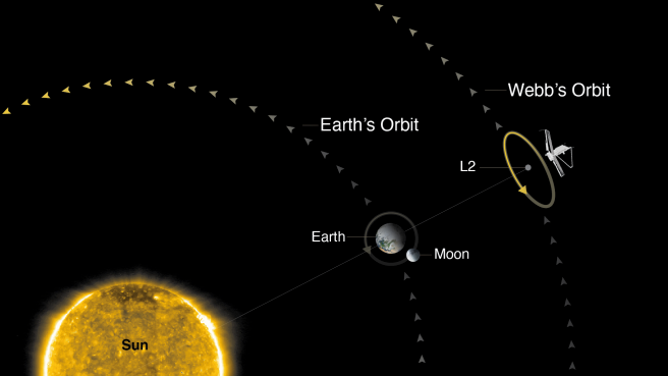James Webb Space Telescope launches on Christmas Day beginning 1 million-mile journey
Ariane 5 rocket launches from French Guiana sending James Webb on its mission to peer back in time and space.

Launch of Ariane 5 rocket on Dec. 25 2021, carrying the James Webb Space Telescope into orbit (Image: ESA/Arianespace/CNES/Optique Vidéo du CSG)
KOUROU, French Guiana – The James Webb Space Telescope, an astronomy mission 25 years in the making, departed Earth on Christmas Day, launching on a European rocket rising above the South American rainforest.
The Ariane 5 rocket launched at 7:20 a.m. ET Dec. 25 from French Guiana. However, Webb's launch is just the beginning of a mission expected to reshape our view of the universe.
Folded up like origami, Webb’s 21-foot, gold-plated mirror and massive tennis-court-sized sun shield were stowed inside the rocket’s nosecone. The specially-designed fairing was made to keep Webb perfectly cooled and comfortable for its ride to space.
After decades on Earth, Webb's golden mirrors met the vacuum of space about ten minutes after launch.
"We have delivered a Christmas gift today to humanity, to people, to NASA, but also to all the people in this room because with this James Webb Space Telescope, we are really enabling new science," European Space Agency Director General Joseph Aschbacher said.
After separating from the rocket's second stage, cheers of jubilation could be heard at the launch control room.
"Go Webb! Go Webb," Range operations manager Jean-Luc Voyer called out. The solar panels were successfully deployed, and Webb is now officially operating independently.
Several days after launch, the spacecraft begins a complicated dance unfolding from its launch cocoon.
Journey to launch
James Webb Space Telescope launches on Christmas Day
Ariane 5 rocket launches from French Guiana sending James Webb on its journey 1 million miles from Earth.
Once known as the Next Generation Space Telescope, the project was renamed for former NASA Administrator James Webb, who led the agency through most of the Apollo program.
The telescope is a collaboration between NASA, the European Space Agency and the Canadian Space Agency, and other international partners. The planning for Webb actually began even before its predecessor, the Hubble Space Telescope, even launched.
Construction of Webb’s massive hexagon mirror made of 18-gold platted smaller mirrors and the overall spacecraft would take 17 years with significant hiccups along the road.
During a 2018 vibration and acoustics test, screws holding the sun shield fell off the spacecraft.
"This is an example of why space systems are thoroughly and rigorously tested on the ground to uncover imperfections and fix them prior to launch," Greg Robinson, Webb’s program director, said at the time of the incident.
Initially budgeted for $1 billion, the mission totaled $11 billion by liftoff. The first target launch date was in 2007.
When it was finally fully assembled, NASA carefully planned the sea voyage from California to French Guiana.
NASA's Goddard Space Flight Center aerospace engineer Sandra Irish oversaw that the telescope could handle the journey to its final destination on Earth.
Irish said the ship's tracking was set to another destination as a decoy to avoid any trouble from pirates or terrorists who would want to hold the $11 billion spacecraft for ransom.
After a 17-day voyage, Webb arrived on Oct. 12 to Port de Pariacabo in French Guiana.
"When they when we got to the port in Kourou, we walked up and asked our engineers to come off the ship. And I just gave him a big hug, and I was almost I was in tears. I was just so overwhelmed by the fact that they made it," Irish said.
What will Webb discover?

Shown here, the James Webb Space Telescope primary mirror illuminated in a dark cleanroom. (Image: NASA Goddard Space Flight Center)
(NASA)
Webb has a laundry list of possible discoveries that scientists hope to accomplish by using sought-after observation time with the telescope.
Webb primarily sees in infrared covering a broader wavelength coverage. Infrared observations are essential because this light can penetrate the dust surrounding stars and planets that are just forming, hiding visible light.
Webb's most talked-about science mission will be to observe areas of space from over 13.5 billion years ago. The telescope will see infrared light emitted by the very first galaxies.
"With light, it kind of acts like a slinky if you can imagine as it travels through the universe, it starts expanding, and by the time it reaches our telescope, it's actually light that we're seeing from some of these earliest galaxies and stars," said Dr. Knicole Colón, an astronomer at NASA's Goddard Spaceflight Center. "And this is light, we've literally never seen before, so we don't know what the early universe looks like, so it's going to be really revealing."
Webb will also look at worlds closer to home and possibly find new planets outside our solar system. The telescope will pay special attention to exoplanets located within the Goldilocks zone, or habitable zone, of their stars. It’s possible Webb could confirm these distant worlds can host liquid water to support life.
"With Webb, we're going to start looking at these atmospheres and see if they are anything at all like Earth," Colón said. "Do they have water, carbon dioxide, methane? So that's how Webb is going to help us advance our search (for life)."
JWST is powerful enough to observe all the cosmos, even see new stars forming or black holes. Its observations are expected to change what we know about the universe and influence future generations of scientists.
The wait is over, but it’s also just beginning

Webb will operate at the second Lagrange point in space. (Image: NASA)
After launch, Webb must complete a series of steps before NASA, and its partners declare it a mission success.
The spacecraft will unwrap itself three days after launch, starting with the five-layer sun shield. Two weeks post-launch, the hexagon mirror segments will assemble to form the large primary mirror.
Webb is scheduled to arrive at its final destination 1 million miles from Earth about 29 days later. This orbit places Webb in the second Lagrange point orbiting the sun.
Then begins the critical testing period to ensure all of its instruments are functioning as designed.
The first science observations aren’t scheduled to begin until six months after launch.
Unlike Hubble, which orbits about 350 miles above Earth, Webb will be too far from Earth for astronauts to repair if something goes wrong.
